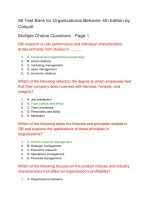Organizational behavior 4th by MShean chap010
Bạn đang xem bản rút gọn của tài liệu. Xem và tải ngay bản đầy đủ của tài liệu tại đây (417.62 KB, 33 trang )
10
Developing
High-Performance Teams
McGraw-Hill/Irwin
© 2008 The McGraw-Hill Companies, Inc. All rights reserved.
Self-Directed Teams at Chrysler
Chrysler CEO Tom La Sorda is
pushing the automaker into an
era of “smart manufacturing”
which relies more on selfdirected work teams (SDWTs).
This photo shows La Sorda
meeting employees at the
company’s plant in Saltillo,
Mexico, which has already
introduced SDWTs.
McShane/Von Glinow OB4e
Slide 10-2
© 2008 The McGraw-Hill Companies, Inc. All rights reserved.
Self-Directed Teams Defined
Formal groups that
complete an entire piece of
work requiring several
interdependent tasks and
have substantial autonomy
over the execution of these
tasks.
McShane/Von Glinow OB4e
Slide 10-3
© 2008 The McGraw-Hill Companies, Inc. All rights reserved.
Self-Directed Work Team Attributes
1. Complete an entire piece of
work requiring interdependent
tasks
• Clusters team members together
• Minimal interdependence with
other teams
2. Substantial autonomy over
execution of the team’s tasks
• Control most work inputs, flow,
and outputs
• Little or no supervision
McShane/Von Glinow OB4e
Slide 10-4
© 2008 The McGraw-Hill Companies, Inc. All rights reserved.
Sociotechnical Systems Elements
• Responsible for entire work process
– Make entire product, component, or provide service
– fairly independent from other work units
• Sufficient autonomy
– freedom to divide up and coordinate work
– empowers team members
• Control key variances
– team controls factors affecting work quality/quantity
• Joint optimization
– balancing social and technical systems
McShane/Von Glinow OB4e
Slide 10-5
© 2008 The McGraw-Hill Companies, Inc. All rights reserved.
SDWTs at Standard Motor Products
Standard Motor Products
successfully introduced selfdirected work teams (SDWTs)
at its Kansas plant, but some
supervisors had difficulty
changing from a commandand-control to mentor/facilitator
management style.
Courtesy of Standard Motor Products
McShane/Von Glinow OB4e
Slide 10-6
© 2008 The McGraw-Hill Companies, Inc. All rights reserved.
Challenges to SDWTs
• Cross-cultural issues
– Difficult in some cultures
• Management resistance
– Concerned about losing power,
status, job security
– Shift from command/control to
mentor/facilitator
• Employee and labor union
resistance
– Employees uncomfortable with
new roles, skills
– Union concerns -- more stress,
lost work rules
McShane/Von Glinow OB4e
Slide 10-7
Courtesy of Standard Motor Products
© 2008 The McGraw-Hill Companies, Inc. All rights reserved.
PricewaterhouseCooper’s Virtual Teams
Peter Nicolas (shown in photo)
and many employees at
PricewaterhouseCoopers spend
much of their time working in
virtual teams. “Virtual teaming is
the norm for us,” says Nicolas, a
Learning Solutions manager at
the accounting firm’s offices in
New Jersey.
Courtesy of PricewaterhouseCoopers
McShane/Von Glinow OB4e
Slide 10-8
© 2008 The McGraw-Hill Companies, Inc. All rights reserved.
Virtual Teams Defined
Teams whose members
operate across space, time,
and organizational
boundaries and are linked
through information
technologies to achieve
organizational tasks.
Courtesy of PricewaterhouseCoopers
McShane/Von Glinow OB4e
Slide 10-9
© 2008 The McGraw-Hill Companies, Inc. All rights reserved.
Why Virtual Teams?
• Increasingly possible because of:
– Information technologies
– Knowledge-based work
• Increasingly necessary because of:
– Knowledge management
– Globalization
McShane/Von Glinow OB4e
Slide 10-10
© 2008 The McGraw-Hill Companies, Inc. All rights reserved.
High-Performance Virtual Teams
Virtual teams perform better with:
Team
Environment
• Creative combination of
communication channels
Team Tasks
• Structured tasks
• Moderate interdependence
Team Size
• Smaller size than traditional
team performing similar tasks
more
McShane/Von Glinow OB4e
Slide 10-11
© 2008 The McGraw-Hill Companies, Inc. All rights reserved.
High-Performance Virtual Teams (con’t)
Virtual teams perform better with:
Team
Composition
• Good communication and crosscultural skills in team members
Team
Processes
• Some face-to-face meetings to
assist team development
Team Trust
• Important in all teams, but
especially virtual teams
McShane/Von Glinow OB4e
Slide 10-12
© 2008 The McGraw-Hill Companies, Inc. All rights reserved.
Trust Defined
A psychological state comprising the
intention to accept vulnerability based
upon positive expectations of the intent
or behavior of another person
McShane/Von Glinow OB4e
Slide 10-13
© 2008 The McGraw-Hill Companies, Inc. All rights reserved.
Three Levels of Trust
High
Identity-based Trust
Knowledge-based Trust
Calculus-based Trust
Low
McShane/Von Glinow OB4e
Slide 10-14
© 2008 The McGraw-Hill Companies, Inc. All rights reserved.
Three Levels of Trust (con’t)
• Calculus-based trust
– Based on deterrence
– Fragile, limited, dependent on punishment
• Knowledge-based trust
– Based on predictability and competence
– Fairly robust, develops over time
• Identification-based trust
– Based on common mental models and values
– Increases with person’s social identity with team
McShane/Von Glinow OB4e
Slide 10-15
© 2008 The McGraw-Hill Companies, Inc. All rights reserved.
Propensity to Trust
• Some people are inherently more willing to
trust others
• Propensity to trust influenced by
personality, values, and socialization
experiences
• Also varies with emotions at the moment
McShane/Von Glinow OB4e
Slide 10-16
© 2008 The McGraw-Hill Companies, Inc. All rights reserved.
Swift Trust in Teams
• People typically join a virtual or conventional
team with a moderate or high level of trust
• Explanations for this swift trust:
– people usually believe their team-mates are
reasonably competent (knowledge-based trust)
– people tend to develop some degree of social identify
with the team
• But swift trust is fragile
McShane/Von Glinow OB4e
Slide 10-17
© 2008 The McGraw-Hill Companies, Inc. All rights reserved.
Team Decision Making Constraints
• Time constraints
– Time to organize/coordinate
– Production blocking
• Evaluation apprehension
– Belief that other team members are silently evaluating
you
• Conformity to peer pressure
– Suppressing opinions that oppose team norms
McShane/Von Glinow OB4e
Slide 10-18
© 2008 The McGraw-Hill Companies, Inc. All rights reserved.
Team Constraints: Groupthink
• Tendency in highly cohesive teams to value
consensus at the price of decision quality
• More common when the:
– Team is highly cohesive
– Team is isolated from outsiders
– Team leader is opinionated
– Team faces external threats
– Team has recent failures
– Team lacks clear guidance
McShane/Von Glinow OB4e
Slide 10-19
© 2008 The McGraw-Hill Companies, Inc. All rights reserved.
Team Constraints: Group Polarization
• Tendency for teams to make more extreme
decisions than individuals alone
• Riskier options usually taken because of
prospect theory effect fallacy -- dislike losing
more than they like winning
McShane/Von Glinow OB4e
Slide 10-20
© 2008 The McGraw-Hill Companies, Inc. All rights reserved.
Group Polarization Process
Team discussion
processes
High risk
High risk
Social support
Persuasive
arguments
Individual opinions
before meeting
Shifting
responsibility
Low risk
Low risk
McShane/Von Glinow OB4e
Individual opinions
after meeting
Slide 10-21
© 2008 The McGraw-Hill Companies, Inc. All rights reserved.
General Guidelines for Team Decisions
• Team norms should encourage critical thinking
• Sufficient team diversity
• Ensure neither leader nor any member
dominates
• Maintain optimal team size
• Introduce effective team structures
McShane/Von Glinow OB4e
Slide 10-22
© 2008 The McGraw-Hill Companies, Inc. All rights reserved.
NASA Encourages Constructive Conflict
Courtesy of Johnson Space Center/NASA
NASA replaced the assigned seating rectangular table at the
Johnson Space Center with a C-shaped arrangement where
people sit wherever they want (shown in photo). The table is
intended to avoid hierarchy so NASA managers can have
more constructive debate.
McShane/Von Glinow OB4e
Slide 10-23
© 2008 The McGraw-Hill Companies, Inc. All rights reserved.
Constructive Conflict
Courtesy of Johnson Space Center/NASA
• Occurs when team members debate their different
perceptions about an issue in a way that keeps the
conflict focused on the task rather than people.
• Problem: constructive conflict easily slides into
personal attacks
McShane/Von Glinow OB4e
Slide 10-24
© 2008 The McGraw-Hill Companies, Inc. All rights reserved.
Rules of Brainstorming
1. Speak freely
2. Don’t criticize
3. Provide as many ideas as possible
4. Build on others’ ideas
McShane/Von Glinow OB4e
Slide 10-25
© 2008 The McGraw-Hill Companies, Inc. All rights reserved.









